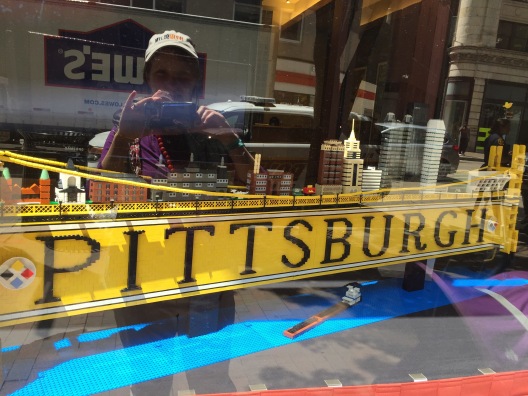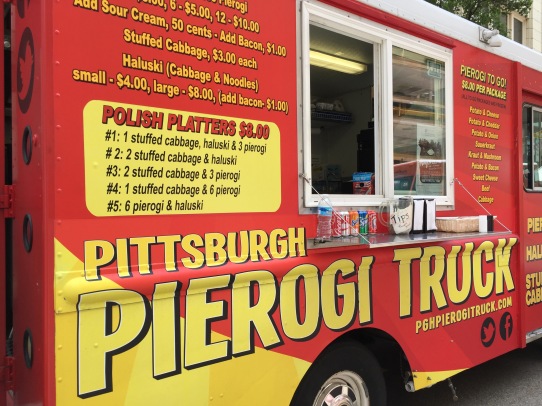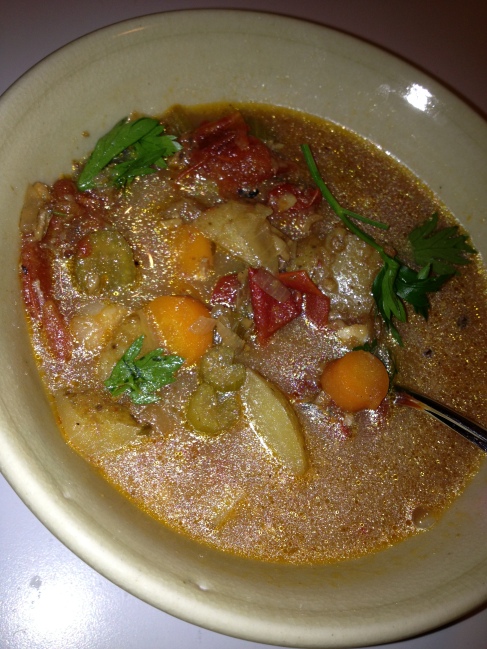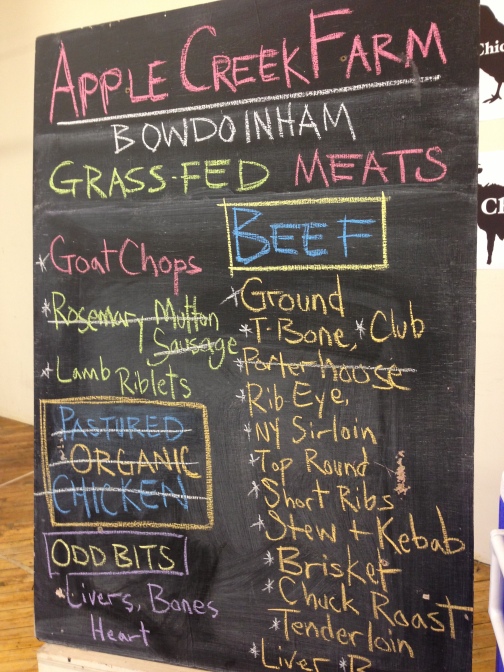Posts Tagged ‘Maine’
Irish Moss Blanc Mange and Panna Cotta with Agar-Agar: Vegan Seaweed Says Move Over, Gelatin!
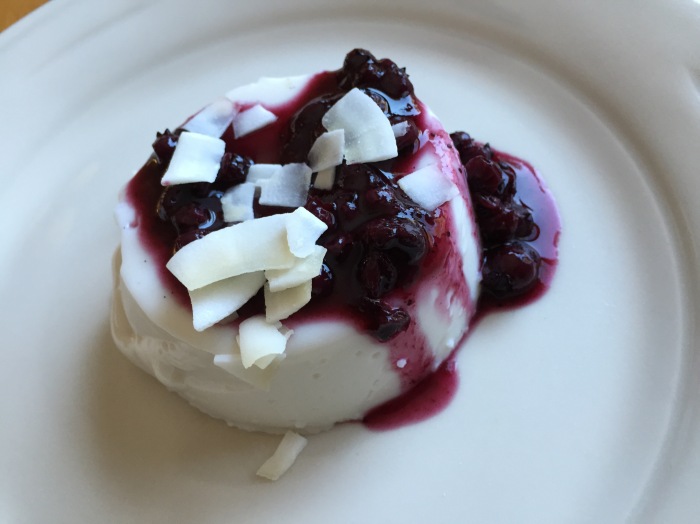
Coconut milk panna cotta, congealed with agar-agar instead of Knox gelatin. (From Heidi Swanson’s “Super Natural Cooking,” recipe ran with my Portland Press-Herald column here.)
As longtime readers of this blog will remember, luscious Italian panna cotta is one of my favorite desserts. I guess that reveals I’m not much of a baker, but I just love how unflavored gelatin coaxes this creamy dessert into an addictive, jiggly texture upon chilling. Still, years ago, when I posted my panna cotta recipe, a vegetarian friend had asked about a suitable non-animal substitute for gelatin that’s since haunted me. She wondered if pectin would work. I found a packet of seaweed-derived agar-agar at an Asian market about that time, but never used it. Its package indicated it would congeal juicy, sugary desserts just like gelatin.
Then I heard about a new (well actually very old-time) technique for congealing milk puddings at this revelatory, delicious seaweed cooking class I took through UMaine Extension in February. Several women in the class waxed nostalgic about how their Maine grandmothers gathered washed-up Irish moss seaweed on the coast to boil into the congealed dessert blancmange. Their enthusiasm inspired my latest The Farm-to-Table Family column for the Portland Press-Herald: “Who Needs Boxed Jell-O When Maine Seaweed Abounds?” (Heidi Swanson’s coconut milk panna cotta recipe is excerpted there.) In that article, I promised to give readers an Irish moss blanc-mange recipe on my blog. Here it is below the picture:

Red algae Irish moss seaweed is boiled with milk in lieu of animal gelatin to make the old-fashioned pudding, blanc mange. It thrives on the Maine coast and is the source of the ubiquitous food additive carrageenan, long extracted here at a plant in Rockland. (Image from Wikipedia)
Irish Moss Blanc-Mange Dessert Pudding
This recipe come from Prannie Rhatigan’s esteemed “Irish Seaweed Kitchen” cookbook. Maine seaweed harvester Kelly Roth of VitaminSea in Buxton told me, “It’s pretty much our bible,” with wide-ranging recipes for incorporating seaweed into quotidian cuisine, from mashed potatoes to pot roast. Rhatigan’s recipe comes from the “hallowed kitchens” of the Ballymaloe House in County Cork, Ireland. Hence the the metric system measurements. You can order dried Maine Irish moss from the websites of local harvesters Maine Coast Sea Vegetables out of Franklin, or VitaminSea from Buxton.
Serves 6
3.5 to 4.5 grams Irish (carrageen) moss, depending on variety (Kelly Roth recommends using the dried seaweed, soaked in fresh water to remove ocean salt)
1 1/2 pints (850ml) milk
1/2 teaspoon vanilla extract or vanilla bean pod
1 1/2 ounce (50g) sugar
1 egg, separated
1. Soak the carrageen (Irish moss) in cold water for 10 minutes, then remove and put in saucepan with milk and a vanilla pod, if using.
2. Bring to the boil and simmer very gently for 15 minutes, semi-covered, taking care that it does not boil over.
3. The carrageen (Irish moss) will now be swollen and exuding jelly.
4. Pour through a strainer into a mixing bowl.
5. Rub the jelly through a strainer and beat it into the milk with the sugar, egg yolk and vanilla essence, if using.
6. Whisky egg white stiffly and fold it gently into the mixture; it will rise to make a fluffy top. Transfer to serving bowl.
7. Serve chilled with a fruit compote (strawberry-rhubarb would be ideal when the season comes late this spring), or a sweet sauce. I served the above coconut milk panna cotta with my Maine wild blueberry-maple syrup preserves.

Found at health food stores and Asian markets, seaweed-derived agar-agar is a good vegan substitute for gelatin.
Heidi Swanson’s Coconut Milk Panna Cotta congeals with seaweed-dervived (from a red algae source similar to Irish moss) agar-agar that I found at my local natural foods store. Use this if you don’t have access to Irish moss. Japanese native, Hiroko Meserve, a mom here in Brunswick, told me she uses agar-agar (called kanten in Japanese) to gel fresh grapefruit juice desserts and also to make the popular Japanese red bean paste sweet, yokan. Agar-agar also gels the popular Chinese almond milk (technically made with apricot kernel, traditionally) pudding know as annin tofu. It masquerades as tofu, when cut into white cubes before serving.
We all know kids love the color and taste of Jell-O. It’s inspiring to discover they love seaweed just as much, and desserts congealed with agar-agar instead of gelatin. I found this out when I went into my son’s preschool last week to read this “Aquaculture for ME” book put out by the Maine Agriculture in the Classroom program. Theo is now obsessed with this book and requests it most nights at bedtime. This program is funded by those Maine agriculture license plates we are proud to sport on our Subaru–get yours today!
I brought the preschoolers a snack of blueberry-kelp smoothies (made with dried Maine kelp I soaked and rinsed of salt) and 100 percent fruit juice vegan Jell-O, thickened with only agar-agar (follow the easy instructions on the package). They particularly gobbled the later up.
Life Gives You Meyer Lemons? Make Limoncello.
Meyer lemons in the store are often tinged with a mildewy flavor. The problem is the rare lemon-orange hybrid citrus ripens quickly and, since it isn’t so self-stable, doesn’t travel easily. They’re a formerly disease-prone hybrid that actually originated in China. So most of the Meyer lemons I’ve had have been a disappointment. Until now.
I was surprised this week with eight perfectly ripe Meyer lemons from a new colleague of Dan’s who hails from Salida, California, and studied at UC-Santa Cruz. They were a gift in exchange for our offer to dog-sit his sweet Julia, a brindled former Mexican street dog Marcos adopted while doing field work there about five years ago. While Theo loved our friend‘s pit-bull Baba, he appears to have developed a new-found fear of canines that I’m hoping to nip in the bud, through aversion therapy:) The gift of the Meyer lemons this week only sweetened the deal.
Marcos relayed that the Meyer lemons come from the backyard of the house where he grew up. His dad passed away last September and since his mom no longer lives there, the tree was loaded with almost overripe fruit. The tree was one of his dad’s prized possessions, in addition to his key lime tree. This detail made me all the more honored to have this fruit, which I approached with reverence. It was tangy-sweet just squeezed into the mouth and into seltzer water.
But a quick search of the web made me realize that when life gives you ripe Meyer lemons, one should turn to limoncello before they go south. I’ve never made limoncello before but have long wanted to. Dan feel in love with it and other fruit liqueurs traveling with his cousin in Italy that summer 2003 just weeks before we met. Most limoncellos only call for the rind but I had golden orbs bursting with juice. I did squeeze a little into my now-famous scallop ceviche. The rest are quartered and bathing in vodka for Meyer Lemon Limoncello, as instructed by the excellent Oregon food blog Voodoo & Sauce (I once interviewed blogger Heather about foraging for stinging netttles). Zester Daily seconded her approach. Next time, I’ll try Meyer lemon mayonnaise.
Whole Fish Stock (with Whiting a.k.a Silver Hake a.k.a Lake Trout, Heads and All!)
It’s my second September living year-round in Maine, and the access to fresh, affordable seafood is one of the things I’m most grateful for after more than a year here. Of course the produce is incredibly bountiful now, though a chill is setting in. I can barely keep up with our C.S.A. and my neglected community garden plot’s bounty. I’m actually a member of three C.S.A.s at the moment–incredibly indulgent I know, though I believe they are saving us money on food costs if you pencil everything out. In addition to the vegetable C.S.A., I just started John Bunker’s incredible bi-weekly “Out on a Limb” heritage apple C.S.A. program. And on and off for almost a year now I’ve had the privilege of being one of the inaugural members of the Salt & Sea Community-Supported Fishery, which does a weekly drop of fresh-from-the-boat fish and shellfish in Brunswick. I’ve had a chance to cook with some of the freshest fillets of pollock, Acadian redfish (my new favorite…especially pan-fried for fish tacos), haddock, dabs and monkfish you can imagine. Every week, owner Justine Simon emails us a suggested recipe for that week’s fish, which can usually be assembled with ingredients you have on hand. It takes all the guesswork out of coming up with dinner and then procuring those items. Effortless, delicious fish dinner!
Unfortunately, Justine says last week’s share caught many members off-guard. I was delighted to get her announcement of whole fish for the first time: “some lovely little whiting (silver hake) tonight from Jerry and crew on the Teresa Mare IV. They caught them close to shore as they were coming in from their trip,” Justine wrote. It’s also GMRI’s fish of the month in their excellent Out of the Blue Campaign.
I’ve had a fascination with whiting ever since living in Baltimore, where filets of the cheap fish are fried and known as the local delicacy, Lake Trout (not from a lake nor a trout). As Justine went on, “Whiting is considered a delicacy in many different types of cuisine, and is more often than not prepared whole.” I’m not sure if you can call young whiting “scrod,” but seems to be similar to young cod, haddock and other whitefish.
The whole fish thankfully came gutted and cleaned. Justine said folks most often remove the head, fins and tail, then dredge the fish in egg and flour and either fry or bake them. But my in-laws had just arrived, so we opted for take-out (something we rarely do) to avoid the mess of frying fish.
So I gladly opted for Justine’s latter suggestion that whiting are perfect for fish stock for those who “don’t want to wrestle with small fish.” I’d never made fish stock before, but this was the perfect alternative, since we weren’t eating the fish right away. Plus, I’ve always been disappointed by the canned version. Doesn’t seem worth paying for doctored water when you have time to make your own. Justine goes on: “I was talking to an Italian woman while the boats were unloading and she gave me a simple recipe that we made last night, and it was delicious:
Fry some onion and garlic in olive oil, cook on low heat until onions are caramelized. Add plenty of water, some salt and the fish. Bring to a boil and let simmer for an hour or so. Strain, so all you are left with is clear stock. Put back in pot, and add more water, finely diced potato and carrot, orzo, parsley, salt and pepper. Yum!”
We simmered potatoes, carrots, celery, fennel, onions and tomatoes from our CSA and/or my garden in the stock, which made for a delicious meal. I just used a mesh ladle strainer to remove the fish bodies, picking off the sweet delicate meat that gave right away from the bone. It would also be perfect for bouillabaisse, cioppino or my grandmother’s Manhattan-style clam chowder.

Bagels from Union Bagel in Portland. Pale perhaps, but still chewy and delicious. At least far better than the insipid, roll-like, Mr. Bagel or Einstein’s alternative.
Surprisingly, Justine reported “overall the whiting didn’t get great reviews from the CSF.” How I often forget my tastes are more exotic and adventurous than my average fellow American. Fortunately, several members rallied to tell Salt & Sea they liked it! So they’ll at least offer it again as a preference that people of which people can opt out. Count me in! I’m ready to continue to get my hands dirty with fresh fish. If only I could have smoked these small fish as a stand-in for whole smoked whitefish at our lovely Yom Kippur break-fast we had with friends this year. I brought the bagels, local Maine lox and cream cheese instead.
Kidneys Aren’t So Offal After All
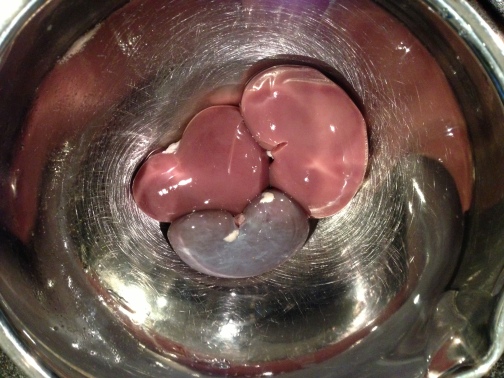
Goat and lamb kidneys (I think the smaller grey one is lamb) from Apple Creek Farm in Bowdoinham. Surprisingly delicious if first soaked in salt water and then alcohol, to remove much of that urine-y essence.
The taste-buds of toddlers, even the most omnivorous of ones, seem to grow pickier near the age of two. That’s certainly been the case with Theo. We depend upon green smoothies, fortified with kale and carrots, to get vegetables into him now. He tends to favor plain starches, bananas and peanut butter, granola and other sweet items these days. So we were delighted to discover he had a taste for lamb kidneys and liver, and tripe soup, at a recent special Greek diner menu at our beloved Trattoria Athena here in Brunswick. I was also happy to discover I had a taste for kidneys, after my unpleasant experience with rabbit ones a while back. And pleased to discover Apple Creek Farm in Bowdoinham sold delicate lamb and goat kidneys at my Brunswick farmers’ market for an affordable $3 a pound. Apple Creek farmers Jake and Abby said the only other customers who ask for them are mothers inspired by Sally Fallon’s Nourishing Traditions.
I’ve bought lamb and goat kidneys twice from them now and found them delicious. I think the goat ones had a more off-putting barnyard aroma, but by eating time, I got confused which was which. To remove the kidneys’ urine flavor (hey, urine is sterile anyway:)), I soaked them in heavily salted water and then some beer the first time and sweet vermouth the second time I made them. For a recipe, I adapted Mark Bittman’s one for breaded veal kidneys sauteed with shallots and sherry, from his How to Cook Everything. I drained the kidneys and discarded their liquid, removed tough white membranes, sliced them into tender medallions, salted and peppered them, then dredged in flour and pan-fried in butter. I kept them warm in a 200 degree oven while I sauteed shallots with more butter in the pan, and then deglazed it with sherry and sweet vermouth and a touch a maple syrup for sweetness. That sauce goes over the kidneys. Serve warm with crusty bread.
Unfortunately, now-finicky Theo refused the kidneys both times at home. Mama sure enjoyed them as an appetizer, but their richness, like liver but with a sweeter, less metallic flavor, meant I couldn’t make a meal of them. A little goes a long way with offal. Let’s hope this kid becomes omnivorous again when he turns two in June. What happened to my keen sardine eater?
Best Fresh Cranberry Sauce (Raw, Local and Sugar-Free!)

Local, organic Maine cranberries, from Sparrow Farm in Pittston. They are also veteran growers of fresh ginger, I just learned!
I have nothing against Ocean Spray. I’m even a fan of their canned, jellied sauce, mostly for its gelatinous texture and the way it lies flat on a turkey and stuffing sandwich. But if you have access to fresh berries, it’s worth making your own cranberry sauce. And you don’t even have to occupy a precious burner on your crowded Thanksgiving stove-top. My favorite cranberry sauce recipe, which I’ve made for years now, is raw, and better yet, sugar-free. This sauce is sweetened with only oranges, apples and dates and whipped up in a blender (preferably a high-powered one like a Vitamix). I often punch it up with orange zest, vanilla extract, cinnamon and nutmeg. I never knew the source of the recipe (see below), but it appears to come from Rose Lee Calabro, an old-school raw foodie. I wish I could remember which dear friend or magazine turned me on to this effortless approach.
I’m excited to receive a pound of local Maine cranberries in our Small Wonder Organics CSA box next week. They’ll be from Sparrow Farm in Pittston, which I also hear has been growing fresh ginger for years. Maybe I’ll finally try Mama Stamberg’s infamous cranberry relish this year.
Cranberry Sauce
by Rose Lee Calabro
2 C fresh cranberries
1 orange
1 apple
1 C dates
water for consistency
Process cranberries, orange, apple and dates in a blender and serve.
Susan Stamberg Ivy Manning
Local Ginger in Maine and Oregon (with Recipes)

Fresh baby ginger (and its rhizome cousin, tumeric) at Chas Gill’s Kennebec Flower Farm stand at the Brunswick Farmers’ Market in early October (all photos by Laura McCandlish, unless otherwise noted).
I had never cooked with fresh, baby ginger before. I remember seeing local ginger once in Oregon, at the Eugene Farmers’ Market, at the Groundworks Organics booth, I believe. But Maine is not Oregon. Artichokes, and even citrus such as Meyers Lemons, are relatively easy to grow in temperate Oregon. It rarely snows during the Willamette Valley’s mild winters. In Oregon, the garlic seed sends up green shoots by November, vegetation that reminds you spring is coming throughout the wet, grey winter. But in Maine, the fall-planted garlic doesn’t poke up until April or May.
So I was more than a little surprised to chance upon locally-grown ginger at the farmers’ market in this harsh clime. At least half a dozen farmers in Maine are growing the niche crop in their unheated, underutilized greenhouses throughout the summer. Leading ginger producer Freedom Farm will speak on a panel about “New Crops [winter-sprouting broccoli, raspberries and ginger] in Tunnels” at MOFGA’s upcoming Farmer-to Farmer conference this weekend.
I first chanced upon ginger at Morning Glory Natural Foods in Brunswick. It was from the Koubek family of The Good Shepherd’s Farm in Bremen, which planted the rhizomes for the first time this season. The Koubeks also supplied Chef Aaron Park (who grew up in Eugene, Ore.!) of Henry and Marty Restaurant here. Park, whose sister lives in Corvallis, pickled the rosy young ginger into the Japanese sushi condiment, gari. He also shaved it over ocean perch and grated it into a beef short rib marinade for Korean kalbi.
The best thing about young ginger is it doesn’t require the painstaking step of peeling before use. Its pink bud-scales lend pickled ginger its natural pink hue. My former KLCC “Food for Thought” show colleague Jennifer recommends throwing in a slice of raw beet to stain the slices a punchier pink. And here’s a shout-out to my former “Food for Thought” colleagues! Eugene Weekly readers recently voted it their second favorite radio show in town.
For pickled ginger recipes, I recommend consulting this one, from my friend Linda Ziedrich, a food preservation guru and cookbook author who homesteads in Scio, Ore. I also drew on the “pickled fresh ginger” recipe from Old Friends Farm in Amherst, Mass., which pioneered the growing of New England ginger back in 2006. Ginger seed supplier East Branch Ginger is another good source of baby ginger recipes.
Alas, the fresh ginger season has come to a close. I’m out of product. Next year, I hope to candy my own crystallized ginger. And I’ve always wanted to try naturally-fermented ginger beer. Oregon master bartender Jeffrey Morgenthaler has this recipe. You can even use the gnarled spent mother-roots of the baby ginger to make the “bug,” so nothing goes to waste.

Sara Iams (left) snatches up some fresh ginger from Chas Gill’s Kennebec Flower Farm at the Brunswick Farmers’ Market.
Donuts in Maine and Oregon

A $5 shift’s end grab-bag from Voodoo Donuts newish location in downtown Eugene, conveniently near the KLCC studio.
I’ve never been much of a doughnut girl. Sure, I’ll indulge in an occasional airy Krispy Kreme or a coconut-frosted from the 24-hour Donut Pub when I lived in Chelsea (as featured in Louis CK), but they generally don’t seem worth the calories. Not my go-to vice. However, Dan (and his dad) love a good donut, so I’m wont to buy them to be a good wife.
While working at KLCC, I once came home with a nasty $5 bucket from Voodoo Donuts. That’s how they clear out the inventory at the end of each shift. It was chock full of Capt’n Crunch, Double-Bubble Gum and rainbow sprinkle-clad donuts, way too syrupy-sweet for my palate. Dan gifted most of them to the OSU economics student lounge, where they were appreciated. The Voodoo thing is more about shock-value than flavor. We did enjoy their Neapolitan (chocolate cake with vanilla frosting, tangy strawberry sugar and marshmellows in whole) and the huge Memphis Mafia (glazed banana fritter topped with peanut butter, nuts and chocolate). Voodoo can not be judged by its mediocre glazed donut. And just say no to Voodoo’s gimmicky Bacon Maple Ale, brewed by Rogue. It’s expensive and supposedly nasty.

OId-school Tony’s Donuts in the other Portland (Maine) is a favorite of my father-in-law’s. Tony’s is known for its molasses donuts, both cake and glazed. Delicious with coffee!
So far, Maine donuts are more my style, with old-fashioned, uncomplicated flavors. I hit up landmark Tony’s Donuts on the drive back from the Portland airport last week. Tony’s kept my father-in-law warm and happy when his Visicu work took him to Maine Med. The sought-after glazed molasses is my order at Tony’s.

Nothing says New England like molasses. They put it in their baked beans, their cornmeal-studded Anadama bread and brew it into dark rum. Tony’s Donuts in Portland is famous for their molasses donuts, both cake and glazed. They’re like a cakey, fried, spiced molasses cookie.
Now, it’s rare that I’ll have two donuts in one week. This is not a habit I’m looking to acquire. But Dan came home from a downtown eye appointment today with two donuts from Frosty’s, whose reputation seems to exceed Tony’s, at least here in Brunswick. The blueberry one tasted artificial, but the glazed buttermilk one, yes buttermilk!, was a revelation. So light and creamy and not at all cloying. Almost like the famous Mrs. Yoder’s sourdough ones at the Richmond Farmer’s Market. These buttermilk donuts won’t help in the ongoing quest to lose the baby weight (sure, blame it on the baby even though you had those pounds to lose before he was even conceived). I was already worried about the freshman fifteen with the stellar dining hall food, which we do partake of here.
Clammy Steamers
Note to self: don’t put the wild-harvested Maine steamer clams in the fridge with the bag sealed. Live shellfish need to breathe. Most of the shells didn’t clench up when tapped, proving my poor mollusks were dead. Their long, fore-skinned necks oozed out of their thin shells, like mini geoducks. They smelled a tad fishy. I meant to put them in a bowl overnight so they could breathe. ‘Tis a pity these guys had to die in vain without someone first savoring their sweet flesh. I love to drink their sweet, briny hot broth, as my Nonny did. So tonight was a vegetarian meal of soothing mujadara, a comforting balm to all the cool rain we’ve had here. Plus, I don’t lack for Maine seafood. I had a regrettable lobster B.L.T. in Rockland Saturday (and yes, I fasted the previous Wednesday). And memorable whiting (in Baltimore we called it Lake Trout) fish and chips to raise the profile of underutilized (unlike their lobster bretheren) Gulf of Maine fish.
Black Trumpet Mushrooms in Maine and Oregon

There’s nothing like a good Willamette Valley pinot to bring out the earthy flavor of mushrooms. These foraged black trumpets stand out in this slighty creamy, gorgonzola pasta.
Maine and Oregon have so much in common from a culinary perspective: an abundance of fresh seafood, blueberries, lots of freely ranging chickens, cattle and pigs. And mushrooms just begging to be foraged from wooded trails. Unfortunately, my foraging in Oregon was limited to easily identifiable golden Chanterelles. I hope to get more adventurous here in Maine and got a good start today with our first black trumpet harvest.
There’s nothing like the serendipity of chancing upon delicious mushrooms while on a hike. It makes the hike more of a hunt. It’s a simple thrill. We saw at least a dozen other mushroom varieties on the hike, but felt too amateur to pick others than the striking black trumpets. Consulting images on the web, I now suspect we saw Lobsters, Yellow-Foot Chanterelles, and Reishis growing on trunks. I’ll have to tag along with someone more senior soon.
If you get your hands on some black trumpets (in Oregon my source was The Mushroomery), you must make this pasta dish (assuming you aren’t dairy or gluten-intolerant. My sister did enjoy it with gluten-free pasta).
Black Trumpet Mushroom and Gorgonzola Pasta (recipe courtesy of Tree and Elaine)
1 oz. dried or fresh mushrooms,
butter
minced shallots
1 cup heavy cream (use 1/2 and 1/2 cream; just as good)
1 oz. Gorgonzola dolce
1 lb. penne pasta (used wild mushroom linguine)
1 c. fresh parmesan
minced parsley, (tarragon-opt.)
Before using, soak mushrooms for 30 min. in warm water, drain and rinse
well to get rid of any remains.
Melt butter and add shallots. Saute 7 minutes,
Then add mushrooms, cream and stir in the Gorgonzola.
Simmer 10 minutes.
Cook the penne with salt till al dente and pour it in skillet with the sauce,
stirring well.
Fold in the parsley and the Parmigiano.
